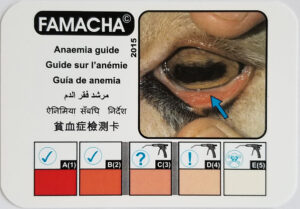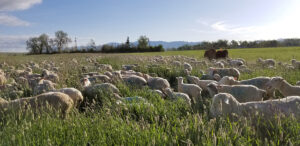Frequently Asked Questions about Integrated Parasite Management
By Dave Scott, NCAT Agriculture Specialist
The Barber Pole Worm constitutes an intimidating challenge to sheep producers on irrigated pastures in the Intermountain West. This roundworm cannot be dismissed, because of the economic impact it can have in terms of loss of gain, reproduction, and even mortality. These frequently asked questions can serve as an introduction to this tipsheet series on Integrated Parasite Management. For a more detailed discussion, see these additional ATTRA tipsheets:
- How Fecal Egg Counts Can Help You Fight Parasites
- Why FAMACHA© Score?
- Grazing to Control Parasites
- Simple Genetic-Selection Strategies to Manage the Barber Pole Worm
With a 180 to 200% lamb crop and high stock density adaptive gazing, sheep can be very profitable. Parasites are perhaps the biggest roadblock to success, and preventing parasites from taking over is an essential part of management.
General
- What is Integrated Parasite Management?
IPM is the coordinated use of refugia (strategic deworming), grazing practices, and genetic selection to limit Barber Pole Worm resistance, ingestion, and ultimately, infection rate. - What is the number one sheep parasite in the Intermountain West?
The Barber Pole Worm, or Haemonchus contortus. Other round worms, such as Trichostrongylus, Teladorsagia, and Cooperia are present, but the Barber Pole Worm causes the most economic impact on sheep flocks. Coccidia, a protozoa, probably ranks as the second-most economically damaging parasite in the Intermountain West. - I am just starting out with a flock on irrigated pasture and after my first two years I have had no trouble with parasites. Do I need to be concerned about parasites?
Unfortunately, you most likely will. They usually show up in the third or fourth year, depending upon your grazing practices. - Can my sheep get parasites in a corral while I am feeding hay?
No, not unless you have grass growing in the corral, such as during spring lambing. The Barber Pole Worm life cycle requires green grass. - I will be running my sheep on dryland range. Will parasites be a problem?
Most likely not. However, watch out for sub-irrigated pastures and irrigated pastures near ranch headquarters where bum lambs, rams, and older ewes are continually grazed all summer long. This is a perfect environment for the Barber Pole Worm.
- Dewormer resistance will ultimately happen. However, you can significantly slow down resistance by the strategic use of a dewormer.
- Dewormer resistance is enhanced by exposing the parasites to dewormers. All of these practices speed up the rate of dewormer resistance:
- The number of times you deworm during the parasite season.
- Deworming all animals indiscriminately.
- Using a long-acting dewormer, such as LongRange.
- Under-dosing dewormer
- On the other hand, refugia slow down dewormer resistance, increasing the effective life of dewormers.
4. How can I tell if my dewormer is no longer working?
- Fecal Egg Count Reduction Test (See tipsheet, How Fecal Egg Counts Can Help You Fight Parasites)
- DrenchRite Assay
- FAMACHA scoring will give you an in-field heads-up. Dewormed sheep that show no positive FAMACHA response two weeks post-worming suggest dewormer resistance. Confirm with a FECRT or DrenchRite Assay.
5. When is a dewormer considered ineffective?
When it does not kill 95% of the parasite adult worms or late-stage L4 larvae. When one dewormer in a class becomes ineffective, the others in that class will be ineffective in a short amount of time, if not immediately.
6. Are there more dewormers for sheep being developed?
Not likely in the near future.

FAMACHA card. Photo: Dave Scott, NCAT
FEC, Refugia, and FAMACHA Scoring
1. What are fecal egg counts used for?
- Identify the type of parasite. This enables a treatment protocol.
- Use in fecal egg count reduction test (FECRT).
- Use in selection of resistant sheep for flock replacements.
- Provide data for National Sheep Improvement Program’s Estimated Breeding Values.
- DrenchRite Assay
See the ATTRA tipsheet, How Fecal Egg Counts Can Help You Fight Parasites.
2. What are refugia?
Refugia are created by limiting the exposure of Barber Pole Worms to a dewormer through selective deworming. This will decidedly reduce developed resistance to dewormers. In contrast, deworming all sheep maximizes exposure to a dewormer and within several years (or less) of intense use, the dewormer becomes ineffective. The concept of refugia is a proven practice. It works.
3. How do I create refugia?
- FAMACHA all sheep first, before deworming.
- Only deworm animals with F3, F4, and F5 score. Leave the rest to create refugia.
- Use one dewormer until ineffective, then change to another in a different class.
4. What is a FAMACHA card?
The FAMACHA card allows quantitative scoring of anemia due to Barber Pole Worm infection. This tool opens the door to successful deworming management.
5. What does FAMACHA scoring measure?
FAMACHA measures the level of anemia, which is an indication of the resistance and the resilience of sheep to the Barber Pole Worm. For an explanation of these two terms, see the tipsheet How Fecal Egg Counts Can Help You Fight Parasites.
6. Why would I want to FAMACHA score?
- Identify wormy sheep before they lose production or, worse yet, die.
- Establish refugia in your flock to prolong a dewormer’s effective lifespan.
- For large flocks, use FAMACHA to select ewe and ram lamb replacements.
- Use as a screening tool when buying sheep. You don’t want to buy infective worms or susceptible sheep.
7. Is FAMACHA scoring worth the trouble? It seems like a lot of work.
Yes, it does seem like a lot of work, but it actually takes less time than you might think. FAMACHA scoring keeps your dewormer working in the long run, and it saves a lot of money in the short run. For example, in a flock of 300 ewes, FAMACHA scoring might reveal that only 70 need to be dewormed. Refer to the Table 2 above and compare the cost of deworming 70 ewes versus deworming all 300.
8. Where can I learn how to FAMACHA score and get the FAMACHA card?
Attend an IPM Workshop.

Two of the three grazing strategies to limit parasite ingestion are demonstrated in this photo: Long pasture rest periods and high stock density, short-duration grazing periods. Photo: Dave Scott, NCAT
Grazing to Control
1. Why is grazing so important in IPM?
It evades Barber Pole Worm ingestion.
2. How?
- Long rest periods allow worm larvae to die on the pasture.
- Short-duration paddock grazing pulls sheep off paddocks before the latest crop of infective larvae reach a perch on the grass leaf.
- Six- to eight-inch paddock residual allows strategic grazing above the infective larvae’s perch.
3. What about plants that produce tannins that inhibit the Barber Pole Worm?
In the Intermountain West, birdsfoot trefoil and sanfoin are known to inhibit the Barber Pole Worm effectively. Additionally, both of these species of legumes are non-bloating. They also require rest periods of at least 40 to 45 days on irrigated pasture, or else they will die out.
4. Are there any other grazing methods that can be used to control the Barber Pole Worm?
- Multi-species grazing. Cattle are not affected by the Barber Pole Worm and the worm cannot reproduce inside a cattle abomasum, creating a dead end. See the ATTRA publication, Multispecies Grazing: A Primer on Diversity.
- Fenceline weaning reduces stress, which, in turn, can reduce parasite infection.
- Be sure to provide adequate nutrition to support the immune system.
Genetic Selection
1. Why can you make such fast progress increasing resistance to the Barber Pole Worm in a sheep flock?
- Over four generations, sires will be responsible for 90% of the genetics in a flock of sheep.
- The heritability of sheep resistance to the Barber Pole Worm is relatively high.
2. How do I select for individuals that are less susceptible to worms?
- Select male and female replacements using fecal egg count testing.
- For large flocks, selecting offspring on the basis of post-weaning FAMACHA score is more practical than FEC and much better than no selection at all.
- Note: for in-flock selection using FEC and FAMACHA, sufficient parasite challenge must be present. See the tipsheet Simple Genetic-Selection Strategies to Manage the Barber Pole Worm.
- Buy rams or ewes with superior Estimated Breeding Values for parasite fecal egg count (PFEC).
Reference
O’Brien, Dahlia. 2018. Managing Dewormer Resistance. Fact sheet. ACSRPC.
Frequently Asked Questions about Integrated Parasite Management
By Dave Scott, NCAT Agriculture Specialist
Published June 2018
©NCAT
IP568
This publication is produced by the National Center for Appropriate Technology through the ATTRA Sustainable Agriculture program, under a cooperative agreement with USDA Rural Development. This publication was also made possible in part by funding from the National Institute of Food and Agriculture, U.S. Department of Agriculture, under award number 2016-38640-25383 through the Western Sustainable Agriculture Research and Education program under subaward number EW 17-011.
Related Publications
- Managing Internal Parasites in Sheep and Goats
- Tips for: Managing Internal Parasites
- Tips for: Preventing Internal Parasites
- Tips for: Treating Internal Parasites
- Tipsheet: Organic Management of Internal and External Livestock Parasites
- Tools for Managing Internal Parasites in Small Ruminants: Animal Selection
- Tools for Managing Internal Parasites in Small Ruminants: Pasture Management


